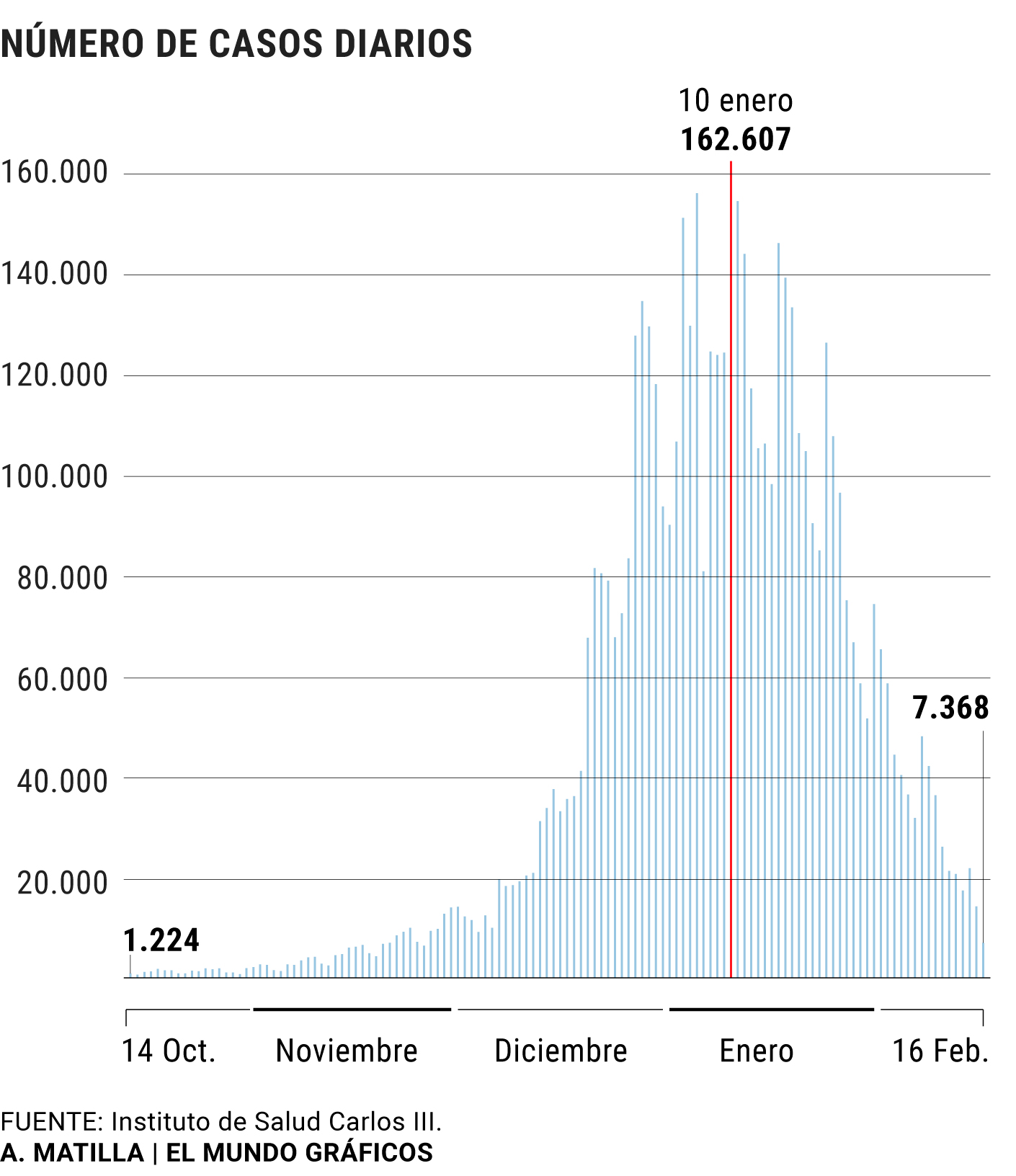Direct Last minute on the coronavirus
Health The coronavirus epidemic is triggered in Denmark: "We must achieve normality without precipitating it by Royal Decree"
Pandemic The sixth wave could cause 15 million real infections: "We only detect between 20% and 30%"
Since October 14,
the sixth wave has already added 5,827,084 cases, 53% of the total of the pandemic
.
In one month, infections have dropped from more than 145,000 daily cases to just over 30,000 that were registered yesterday and the cumulative incidence of 14 days per 100,000 inhabitants has dropped from 3,397.60, which was the peak of this epidemic wave up to 919.48 yesterday, four times less.
In the last week it has dropped 542.23, less than it did the previous one, when it exceeded 800 points of decline (2,299.44, was the incidence 15 days ago).
With this abrupt drop in the figures, some experts venture to predict that, in two weeks, at the beginning of March,
we could recover the favorable situation prior to the month of December
: a cumulative incidence of close to 100 cases.
"This decline is taking place in the same way that it occurs in other countries," explains Jesús Molina Cabrillana, spokesperson for the Spanish Society of Preventive Medicine, Public Health and Hygiene (Sempsph).
This would be good news, since "
maintaining this incidence for a few weeks and lowering it even more at the gates of a new season, could be the opportunity to abandon certain measures
", underlines Molina.
It is enough to remember that also in little more than a month the vertiginous sixth wave took place, pushed by the omicron variant.
From December 17 to the peak of January, the accumulated incidence multiplied by five, since it went from 511.00 to more than 3,300.
During this time, the reproduction number or contagion rate, the famous R, remained above 1.30 for more than two weeks.
The consequence: the
high infection peaks from December 27 to January 27
, above 100,000 cases.
The decrease in cases in Spain coincides with the global situation
.
The largest global wave of contagion from the pandemic, which began last November due to the emergence of the omicron variant, continues to decline after reaching its peak in January, with
a 19% decrease in cases of Covid-19 last week,
although the deaths continue to rise, 4% in the period studied, as pointed out by the World Health Organization (WHO) in its weekly epidemiological report.
It should be noted that
more than half of the cases registered in the week occurred in Europe
(9.5 million, 16% less than in the previous seven days), while in America 3.2 million were registered, a decrease of 32%, and in South Asia 915,000, which meant a decrease of 37%.
The only region where there was an increase in cases was East Asia, where 1.5 million new positives were recorded and this represented an increase of 19% compared to the previous week.
For this reason, in most Western countries steps are being taken to restore normality and measures and restrictions are being eliminated.
Molina emphasizes that the steps taken in returning to the pre-pandemic situation are firm, "
what cannot be done is to be removing and setting standards. People are driven crazy and confused
. When the measures are lifted, they must be sure that you can. The month of March can be a good month for it, since it coincides with the change of season".
In this sense, referring to Denmark, the preventivist expresses that "
removing all the measures at once offers the lack of a feeling that everything has happened and it is not like that
".
But he does see that in the medium term the masks, "which we must keep indoors, for the time being", can be relaxed or left "only for certain situations in which public spaces are shared, such as transport, large surfaces... ".
Molina Cabrillana agrees with pediatricians on the progressive liberalization of the mask in schools, but "always with caution and once we get the infection rates to be low and stay that way."
As for the mortality data, which is notable for being high in recent days, the preventivist assumes that
"they fall within what is expected after having had so many cases
."
In the
last wave, 11,081 official deaths have already been added.
Thus, in the last seven days, according to the Health report, 664 deaths have been registered and 288 have been added from Thursday to Friday.
Spain, in a better position than its European neighbors
According to the latest data provided by Health regarding the evolution of the pandemic in several European countries (February 17), Spain has the lowest incidence, while the transmission record is recorded by the Netherlands, with 7,507 cases per 100,000 inhabitants. in 14 days.
In addition, the transmission in Switzerland is 4,091 cases;
in Portugal it stands at 4,089;
in France at 3,314 and in Germany at 3,143.
"The drop in Spain is much more abrupt than initially thought.
It is good news, because it was not clear that it had this speed," explains Manuel Franco, spokesman for the Spanish Society of Public Health and Health Administration (Sespas), who maintains the prudence about the evolution in the month of March because "doing these calculations with omicron and without restrictions is complicated" and trusts in the impact of vaccination.
Conforms to The Trust Project criteria
Know more
covid 19
Coronavirus
Omicron variant
Europe
Germany
France
Portugal
Switzerland
Denmark
Asia
America
Covid-19The Danish "experiment": a return to normality with a record number of infections and less occupancy in ICUs
Covid-19Germany will not lift restrictions against Covid
Covid-19 Immunologists point out that with two doses and an omicron infection "a third" dose of vaccine would not be necessary
See links of interest
Last News
Topics
Work calendar 2022
The richest
Time change
Live: Valencia Basket - UCAM Murcia
Elche - Vallecano Ray
Live: Barcelona - Baxi Manresa

